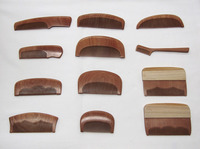

Total:131items
- Pottery & Porcelain (18)
- Lacquerware (4)
- Glasswork (2)
- Wood & Bamboo Work (19)
- Leather Work (1)
- Papermaking (13)
- Textile (20)
- Dyeing products (5)
- Masonry (1)
- Metal Work (11)
- Stationery (4)
- Accessory (4)
- Livingware (3)
- Toys & Entertainment (14)
- Interior (2)
- Other crafts (10)
- Osaka Shamisen (Japanese three-stringed guitar)
- Kyo-Hanga: Kyoto woodblock print
- Hyuga Kendo Armor
- Kanazawa-Haku: Kanazawa Gold Leaf
- Simotsuke-Suisha: Simotsuke Waterwheel
- Koshigaya-Katchu: Japanese traditional armor
- Ise netsuke : Ise miniature wooden sculpture
- Yuton: Lacquered Paper Mat
- Iwami Kagura Mask
- Oroku-gushi: Oroku-gushi Combs

 |
Main Production Site:Nagano |
 《Characteristics》
《Characteristics》Oroku-gushi Combs are the practical combs made of wood - Approximately 100 thin teeth are placed to the shaft that is shorter than 10 cm. Kiso Village (Kiso County, Nagano Prefecture) is their main production site. Located in the uppermost portion of Kiso river, this community is prospering as the "water resource village" because of dense forests and rich water resources.
Today, all wooden combs made in Yabuhara (Kiso Village) are called Oroku-gushi Combs. More specifically, they are classified into four types by uses and functions: Sukigushi (fine-teeth comb for cleaning and removing dirt), tokashigushi (wide-teeth comb for untangling and straightening), sashigushi (decorative comb) and yuigushi (hair-binding comb). Further, they are classified by shapes, sizes and teeth type and called in different names.
[Traditional tool craft designated by the Governor of Nagano Prefecture]
Information provided by: Industrial Promotion Division of Kiso Village office,
Kiso Village Oroku-gushi Artisan Association
Translation by: Tomoko Yamamoto, reviewed by Eri Hara

| Materials | Minebari woods |
|---|---|
| Crafting Processes | Most Oroku-gushi combs are made of local Minebari wood. In the Japanese name, the Minebari tree is called Ono-ore kamba (axe-breaking birch) because of its extremely hard texture that can break an axe. Minebari itself is a local name. People say the name originated from the way trees grow -- starting from the rocky soil, their roots grow uphill and extend up to the steep slopes (mine means steep mountain slope, bari means extending or projecting). It results the strong, dense yet flexible wood that is ideal for making the fine-teeth combs including Oroku-gushi combs. In Nagano, Minebari trees are found at high-altitudes in Saku, Kamiina and Shimoina districts.
Woodworking processes 1. Lumber milling Raw timber is sawn into boards. 2. Preparation for sawing Kidori (preparation) craftsmen prepare and cut the lumber for combs. Their sizes must be slightly wider than finished widths. 3. Air-drying Kidori craftsmen dry the lumber in the open air for approximately 2-3 years. 4. Planing/shaving lumbers It's also Kidori craftsmen's job. They use planes (kannas) to flatten lumber into boards of standard thickness and form. 5. Measuring and cutting boards into the comb size After measuring the length, width and thickness on boards with rulers, Kidori craftsmen cut them into the comb size. 6. Marking From this process to finishing, comb craftsmen take care of all. They make marks (sujis) along the piece of board from the last cut to the end with a special tool. Sujis are going to be the points of the teeth. 7. Cutting the teeth Comb craftsmen use the special fine-teeth saws to cut the teeth into the front side of each board. 8. Rasping the teeth with hadoshi (fine-teeth) Comb craftsmen use special rasps called hadoshi (attached with dried scouring-rush (tokusa) shoots) to smooth the teeth. 9. Cutting the teeth (with nakanuki saw) To cut the teeth deeper, comb craftsmen use special saws called nakanukis. These saws are effective for cutting the parts that the fine-teeth saws cannot reach and trimming all teeth even. 10. Cutting the teeth (with yamanuki saw) To perfect the depth, comb craftsmen need to cut on the backside of the teeth as well. With another special saws (yamanukis), they cut them down to marked points. By this time, cutting will be completed. 11. Cutting edges Craftsmen cut all four edges of combs with planes. They need to change the blade angle for the perfect cuts. 12. Smoothing edges After cutting, craftsmen use special planes to smooth edges. 13. Polishing Craftsmen polish the whole combs with tokusa shoots, sea shells (Bouzu) and deer bones. 14. Finishing After polishing, they soak the camellia oil into combs and all teeth until the whole comb is covered. You need to allow the oil to soak. |
| History | Kiso wooden combs originated from Seinaiji (Simoina District) and Tsumago, Arraragi in (southern parts of Kiso District). It is said that later, they were introduced to the northern parts of Kiso District. Presumably, craftsmen in Yabuhara jyukus (inns) started making combs between the Genroku (1680 - 1709) and Kyoho period (1716 - 1735) and combs became popular as people started to call them Oroku-gushis from around 1800.
Legend of Oroku Legend has it that a girl called Oroku who was a daughter of the inn (hatago) owner in Tsumago (currently, Minami-kisomachi, Kiso County). Suffering from headache, she climbed the nearby Mt. Ontake and made a wish to Ontake-daigongen (manifestation of Buddha) who told her to make a comb from the Minebari tree for the cure. She combed her hair with the comb until her headache disappeared completely. Since then, people have been calling the comb that she used Oroku-gushi Comb. |
| Related URL | https://www.vill.kiso.nagano.jp/kosodate_kyoiku/meisho/whats.html |
◆Exhibition / Showcase
For more information
Kiso Village Office
1191-1 Yabuhara, Kiso Village, Kiso County, Nagano Prefecture 399-6201 JAPAN
Tel: +81-(0)264-36-2001
Fax: +81-(0)264-36-3344
(Japanese only)



